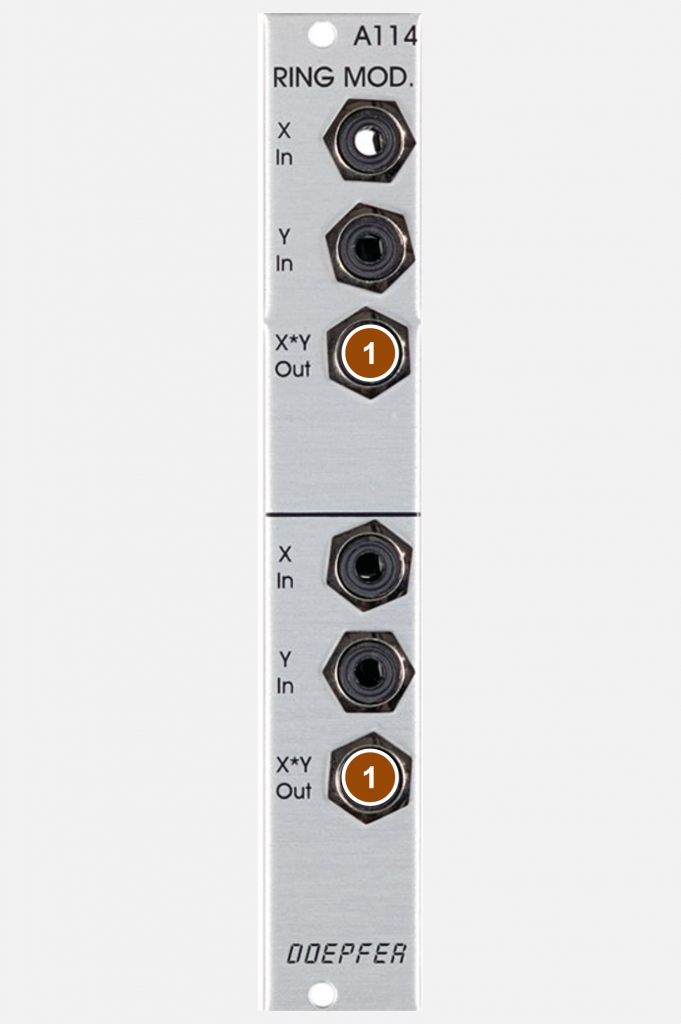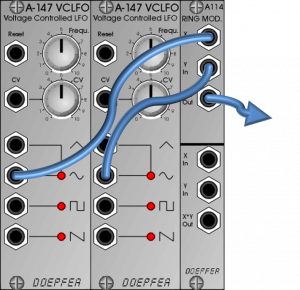From a mathematical point of view, a ring modulator forms the product of two signals and then subtracts the sum of the signals from it: a * b – (a + b)
Unfortunately, this great formula does not make us any smarter in terms of sound. Actually, this is “only” amplitude modulation, which, in contrast to a VCA, also allows negative amplification (inversion). Therefore, if one of the two input signals has a very low frequency, you get tremolo-like sounds.
The ring modulator always requires two input signals: If there is only one input signal (regardless of which of the two inputs) is present, you will not be able to hear any signal at the output.
User interface
Inputs:

- X In: Audio or control voltage input (included in both sub-modules)
- Y In: Audio or control voltage input (included in both sub-modules)
Outputs:

- X*Y Out: audio output (included in both sub-modules)
Pretty minimalist, right?
Bells and inharmonic overtones
Ring modulators are often used for “bells”. This is simply because ring modulation very easily creates non-harmonic series of overtones that also occur in “sounding metal”. To do this, two oscillators are detuned against each other and fed into the two inputs.
Ring-modulated control voltages

In addition to audio signals, control voltages can of course also be processed – with two LFOs, very complex modulation signals are created in this way.
Most beautiful in the CS-80?
The ring modulator in the Yamaha CS-80 has a fast and frequency-modulated LFO as its second input, in addition to the actual synthesizer voice.

Alternatives
The A-114 ring modulator is inexpensive, space-saving and also equipped with double functionality (2 ring modulators). Who only needs a single ring modulator and instead additionally requires a Sample & Hold (or Trig & Hold) circuit, as well as a simple slew limiter, can also use the new module A-184-1 Ring Modulator / S&H/T&H / Slew Limiter Combo.
Do you have more rack space and perhaps a need for more in-depth ring modulation control? Then it’s worth taking a look at the A-133 Dual Voltage Controlled Polarizer: In principle, a voltage-controlled polarizer is nothing more than a ring modulator, but it also offers the additional option of controlling the intensity of the modulation using an attenuator. Reduced to 4 HP, but still an improved version of the A-133 is the A-133-2.
Sound examples
-
A-114 / Sine ring modulation
Two A-143-9 QLFOs serve as input signals for the A-114 Ring Modulator: The two sine outputs go to the “X In” and “Y In” inputs of the first ring modulator, the 90 degree phase-shifted cosine outputs go to the “X In” and “Y In” inputs of the second ring modulator. The two outputs of the A-114 are distributed left and right in the stereo image.
In addition, the QLFOs are modulated by an A-110-6 (sine and cosine outputs). Some reverberation from the DAW, during the sound example I manually change the frequencies and modulation depths on the A-143-9 and A-110-6.
Two sine wave oscillators in the A-114.
Technical specifications
| Width | 4 HP |
| Depth | 40 mm |
| Power requirements | 40 mA (+12V) / -30 mA (-12V) |

